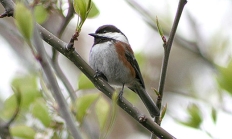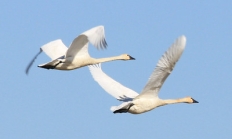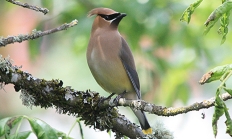
Search myodfw.com
Not sure what to do with a fishing rod even if you had one? Thought about hunting but getting started seems like an impossible task? Then let us help you. During ODFW's hands-on workshops and family fishing events we will provide the instruction and gear you'll need to actually catch a fish or shoot a pheasant. Other classes will help you navigate the controlled hunt process, or show you what equipment you'll need to hunt or fish.

Graceful and tern-like in many of its actions, this striking little gull displays flashing white outer primaries that contrast with a gray back. The Bonaparte's gull is an abundant spring and fall transient along the coast, primarily over the ocean just offshore and is fairly common and widespread elsewhere in Oregon, usually in flocks of less than 100. Larger flocks of up to 1,000 have occurred at Fern Ridge Reservoir in Lane County, during extreme storm conditions, and in the Klamath Basin. Hear the call of the Bonaparte's gull Photo by Martyne Reesman, ODFW

These, the most numerous jaegers off Oregon, are slightly smaller than Herring gulls. Gull-like and graceful, these piratical birds steal food from smaller seabirds. They come in a bewildering array of light and dark individuals, confounded by age and sexual differences. The Pomarine jaeger is an uncommon spring and fairly common fall transient offshore two to 50 miles, following shearwaters. Sightings have been centered near the continental shelf edge. They are occasionally observed from shore in fall. Hear the call of the Pomarine jaeger Photo by Martyne Reesman, ODFW

Gray jays are common visitors at mountainous campsites and parks and are commonly known as "camp robbers" for their habit of taking food from humans. Gray jays in the Blue Mountains have the top of their heads white, while birds in the Cascades and Coast ranges have white restricted to the forehead. Coast Range birds are decidedly browner vs grayish overall. In Oregon, the Gray jay resides in conifer forests of the Coast and Cascade ranges, the eastern slope of the Cascades at Ft. Klamath and in the southwestern part of the state. Hear the call of the Gray jay

This is one of the most audacious of Oregon's resident avifauna both in appearance and behavior. Its black coat and streaming tail dappled in blue-green iridescence contrasts starkly with its flashing white wing feathers during flight. Common and conspicuous east of the Cascades, the magpie prefers open areas stippled with dense thickets or trees. They are highly social, often gathering in large flocks. Historically despised and persecuted by hunters, farmers, and ranchers, this trickster has flourished in the tradition of the coyote. Hear the call of the Black-billed magpie Photo by Kathy Munsel, ODFW

Chestnut-backed chickadees are one of the most common species of bird in conifer forests of western Oregon. They are distinguished from other chickadees by their chestnut-colored back, lack of an eye-line, and their wheezy song. Like other chickadees, they are frequently observed performing acrobatic maneuvers such as hanging from branch tips while foraging high in the canopy. They also frequent bird feeders for suet and sunflower seeds, and will nest in boxes if they are placed near groves of conifers. Hear the call of the Chestnut-backed chickadee Photo by Kathy Munsel, ODFW

Adult Northern leopard frogs have smooth skin that is green or brown and covered with dark brown spots outlined with white rings. Females grow to just over four inches in length; males are slightly smaller at just over three inches. They live in and near various water sources with abundant vegetation such as wet meadows, marshes, riparian areas and moist, open woodlands. These frogs use the vegetation, such as grasses, sedge, weeds or brush, as cover from predators. During the winter, they need ponds or slow-running streams for hibernation. Photo from ODFW

The buzzy, insect-like song of the Savannah sparrow is a characteristic sound of open landscapes dominated by grasslands throughout Oregon. Savannah sparrows are usually heard or seen when perched atop a fence post, small shrub, or tall weed, or running on the ground between openings in vegetation until the bird abruptly drops down into cover. The Savannah sparrow nests on the ground, often in a slight depression and well concealed by a canopy of dead vegetation or partially tucked under a clump of vegetation. Hear the song of the Savannah sparrow Photo by Dave Budeau, ODFW

This is a bird of riparian thickets, farmlands, and towns. Since 1980, it has been observed almost annually in Harney County, usually in numbers less than five. A pair successfully fledged young near the Malheur National Wildlife Refuge headquarters in 1994. Most Harney County records occur from early April to late October. Away from Harney county individuals have also been seen in the various eastern and southeastern counties of Oregon. Hear the song of the Great-tailed grackle Photo by Kathy Munsel, ODFW

The Western gray squirrel is the largest tree squirrel in the state. It occurs from central Wasco, Jefferson, Deschutes, and Klamath counties west, except for unforested portions of the Willamette Valley, to central Washington, Benton, Lane, Douglas, Coos, and Curry counties. It is commonly associated with mixed forest communities. These squirrels are wary and secretive, but curious; they examine new objects placed in their environment but, once captured, they often avoid live traps. Western gray squirrels are an Oregon Conservation Strategy Species in the Willamette Valley ecoregion. Photo from ODFW

Much variability in coloration exists in the common garter snake but the best identifying characteristic is a stripe down the middle of the snake's back. While the common garter snake frequents wet meadows and forest edges, it occurs in a variety of habitats far from water, including open valleys and moist coniferous forest. Smaller snakes eat earthworms, but adults feed on a variety of vertebrate prey, including frogs, toads, salamanders, birds, fish, reptiles, and small mammals. Invertebrates, including slugs and leeches, are also eaten. Photo by Dave Budeau, ODFW

WILLAMETTE WILDLIFE VIEWING December 4, 2025 Corvallis area EE Wilson Wildlife Area There are lots of deer, shorebirds and waterfowl to see on the wildlife area – look for goose, mallard, hooded merganser and wood duck broods. Wildlife viewing remains good for waterfowl and shorebirds. Note: Dogs are required to be on a leash inside the wildlife area boundary. Rifles and pistols are prohibited year-round. Find directions to EE Wilson Wildlife Area. A parking permit is required to park at EE Wilson Wildlife Area. Find out how to buy a parking permit. Eugene area Fern Ridge Wildlife Area Observant visitors
One of Oregon's characteristic offshore seabirds, these stocky gull-like birds with steep foreheads come in a broad range of color morphs from white to slate gray, with buffy, bluish-gray, mottled and brown intermediates. The round head and pecking motion of birds feeding on the water is reminiscent of the shape and behavior of pigeons. The heavy hooked bills are divided into colorful plates of green, yellow, and orange, with large tubed nostrils atop. They are irregularly common to abundant in Oregon in winter, especially beyond five miles from shore. Hear the call of the Northern fulmar Photo by Martyne Reesman

Smaller than a robin, this shy skulker is difficult to see, even though it is present during the nesting season in marshes throughout the state. The Sora is mostly brown with a black face and a stout yellow bill. Its chicks are small black balls of fluff with a bit of orange feathering under their chins. In the breeding season, Soras use wet meadows, including sedge, rush, and hair grass types but also wet areas with emergent vegetation, particularly cattails and tulles. They eat invertebrates, seeds, plant leaves, and stems. Hear the call of the Sora Photo by Kathy Munsel

Often mistaken for a duck, the American coot is actually a member of the rail family. It is a smallish, slate-gray water bird with a white bill. At home swimming in ponds and marshes, it seems to propel itself through the water by rhythmically extending its neck. During the nesting season it can be seen enthroned on a sizable nesting platform built from marsh vegetation. It has the largest Oregon breeding population of any waterfowl. Rafts of thousands of coots stage for migration in spring and fall on lakes throughout Oregon. Hear the call of the American coot Photo by

This majestically crested bird is often heard before being seen due to its conspicuous harsh rattling call. Kingfishers are most frequently associated with lake and pond shorelines and islands, as well as coastal dunes with ponds and widely scattered shrubs and trees. They hunt from a vantage point above water such as an overhead branch, telephone wires along shore lines or pilings of piers. This is a common permanent resident throughout most of the state except in the north Lake and east Deschutes counties where open water is generally absent Hear the call of the belted kingfisher Photo from ODFW

Spirited vocalizations make this handsome clown-faced woodpecker one of the more conspicuous residents of much of Oregon's oak woodland. It is unique among Oregon woodpeckers with its habits of communal living and acorn storage. It is fairly common in the Rogue Valley and adjacent hills and locally common in the Klamath River Canyon in southwest Klamath county and the southern part of the Willamette Valley. Acorn woodpeckers are Oregon Conservation Strategy Species in both the Klamath Mountains and Willamette Valley ecoregions. Loss of oak woodlands poses a major threat to this bird. Hear the call of the Acorn woodpecker Photo

Of several swans found in Oregon, the tundra swan is by far the most common during the non-breeding season. It is most readily distinguished from the similar-appearing trumpeter swan by voice, although subtle differences in physical appearance and behavior can separate the two with difficulty. It is a fairly common transient throughout the state but most abundant at large bodies of water and wetland complexes east of the Cascades including the Malheur National Wildlife Refuge and the surrounding Harney Basin, Summer Lake Wildlife Area and the Klamath Basin. Hear the call of the tundra swan Photo by Kathy Munsel, ODFW

One of Oregon's most efficient fruit-eaters and a perennial irritant to cherry, blueberry, and grape growers, the Cedar waxwing is a sleek, social resident of mixed forests and urban areas throughout the state. Smooth, tan-brown plumage, a black mask with a mall head crest, red waxy wingtips, and a yellow tipped tail give Cedar waxwings a distinctive appearance. The breeding range of the Cedar waxwing covers most of Oregon, except for the extensive conifer forests and expansive treeless areas with greater breeding populations reported in lowlands. Hear the call of the Cedar waxwing Photo by Kathy Munsel, ODFW

The song of this bird is one of the characteristic sounds of spring evenings in much of the high desert country of eastern Oregon. This temperate migrant is a ground-nesting, ground-foraging bird of most of the grassland, agricultural land, and shrubs steppe habitats of Oregon. The streaked brownish plumage of the Vesper sparrow is similar to that of several small to medium-sized sparrows, except for white outer tail feathers, shown most conspicuously in flight. The Oregon vesper sparrow is an Oregon Conservation Strategy Species in the Klamath Mountains and Willamette Valley ecoregions. Hear the song of the Vesper sparrow Photo

